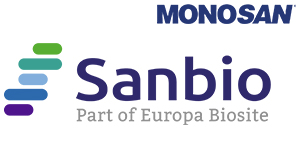Anti-LYRIC Antibody Picoband™ (monoclonal, 2E5G3)
Anti-LYRIC Antibody Picoband™ (monoclonal, 2E5G3)
Artikelnummer
SANMON23904
Verpackungseinheit
100μg
Hersteller
Sanbio / Monosan
Verfügbarkeit:
wird geladen...
Preis wird geladen...
Clone Number: 2E5G3
Immunogen: E.coli-derived human LYRIC recombinant protein (Position: D101-Q270). Human LYRIC shares 94% amino acid (aa) sequence identity with both mouse and rat LYRIC.
Concentration: Adding 0.2 ml of distilled water =f 500 μg/ml.
Format: Lyophilized
Storage buffer: Each vial contains 4mg Trehalose, 0.9mg NaCl, 0.2mg Na2HPO4, 0.05mg NaN3.
Additional info: At -20°C for one year from date of receipt. After reconstitution, at 4°C for one month. It can also be aliquotted and stored frozen at -20°C for six months. Avoid repeated freezing and thawing.Adding 0.2 ml of distilled water will yield a concentration of 500 μg/ml. Background: MTDH (Metadherin), also known as protein LYRIC or astrocyte elevated gene-1 protein (AEG-1) is a protein that in humans is encoded by the MTDH gene. AEG-1 is involved in HIF-1alpha mediated angiogenesis. AEG-1 also interacts with SND1 and involved in RNA-induced silencing complex (RISC) and plays very important role in RISC and miRNA functions. AEG-1 induces an oncogene called Late SV40 factor (LSF/TFCP2) which is involved in thymidylate synthase (TS) induction and DNA biosynthesis synthesis. Late SV40 factor (LSF/TFCP2) enhances angiogenesis by transcriptionally up-regulating matrix metalloproteinase-9 (MMP9). AEG-1 acts as an oncogene in melanoma, malignant glioma, breast cancer and hepatocellular carcinoma. It is highly expressed in these cancers and helps in progression and development of these cancers. It is induced by c-Myc oncogene and plays very important role in anchorage independent growth of cancer cells. Subcellular Localization: Tissue Specificity:
Applications: WB,IHC,FC
Immunogen: E.coli-derived human LYRIC recombinant protein (Position: D101-Q270). Human LYRIC shares 94% amino acid (aa) sequence identity with both mouse and rat LYRIC.
Concentration: Adding 0.2 ml of distilled water =f 500 μg/ml.
Format: Lyophilized
Storage buffer: Each vial contains 4mg Trehalose, 0.9mg NaCl, 0.2mg Na2HPO4, 0.05mg NaN3.
Additional info: At -20°C for one year from date of receipt. After reconstitution, at 4°C for one month. It can also be aliquotted and stored frozen at -20°C for six months. Avoid repeated freezing and thawing.Adding 0.2 ml of distilled water will yield a concentration of 500 μg/ml. Background: MTDH (Metadherin), also known as protein LYRIC or astrocyte elevated gene-1 protein (AEG-1) is a protein that in humans is encoded by the MTDH gene. AEG-1 is involved in HIF-1alpha mediated angiogenesis. AEG-1 also interacts with SND1 and involved in RNA-induced silencing complex (RISC) and plays very important role in RISC and miRNA functions. AEG-1 induces an oncogene called Late SV40 factor (LSF/TFCP2) which is involved in thymidylate synthase (TS) induction and DNA biosynthesis synthesis. Late SV40 factor (LSF/TFCP2) enhances angiogenesis by transcriptionally up-regulating matrix metalloproteinase-9 (MMP9). AEG-1 acts as an oncogene in melanoma, malignant glioma, breast cancer and hepatocellular carcinoma. It is highly expressed in these cancers and helps in progression and development of these cancers. It is induced by c-Myc oncogene and plays very important role in anchorage independent growth of cancer cells. Subcellular Localization: Tissue Specificity:
Applications: WB,IHC,FC
| Artikelnummer | SANMON23904 |
|---|---|
| Hersteller | Sanbio / Monosan |
| Hersteller Artikelnummer | MON23904 |
| Verpackungseinheit | 100μg |
| Mengeneinheit | STK |
| Reaktivität | Human |
| Klonalität | Monoclonal |
| Methode | Western Blotting, Flow Cytometry, Immunohistochemistry |
| Isotyp | IgG2b |
| Wirt | Mouse |
| Konjugat | Unconjugated |
| Produktinformation (PDF) |
|
| MSDS (PDF) |
|

 English
English







